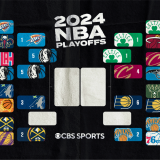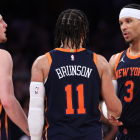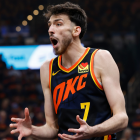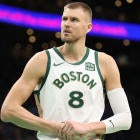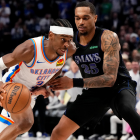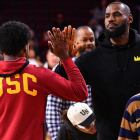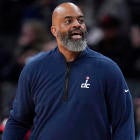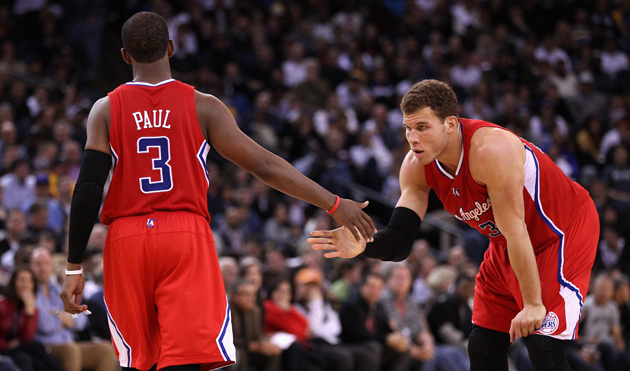 |
| Chris Paul and Blake Griffin proved to be a potent pair for the Clippers in 2011-12. (Getty Images) |
Over the next month, CBSSports.com's Eye On Basketball will take a team-by-team look at the 2012 NBA offseason. Next up: the Los Angeles Clippers. You can find our offseason reports here.
I. How they finished 2012: The Los Angeles Clippers didn't just take two steps forward, by jumping out of the 2011 lottery into the 2012 playoffs, where they defeated the Memphis Grizzlies in the first round, they actually reached a franchise peak last season. That's right: their 40-26 record in the lockout-shortened season produced the best winning percentage (.606) in the franchise's 42-year history, topping the previous high-water mark of .598, set back in 1974-75, when the team was still known as the Buffalo Braves. What's more, the Clippers' dramatic 7-game series win over the Grizzlies was just the second playoff series victory since the team relocated from Buffalo to San Diego and took on the "Clippers" moniker in 1978. Yes, you read that correctly: two playoff series victories in 34 seasons in California.
What a difference the Chris Paul trade made, eh? When the Clippers acquired the All-Star point guard from the New Orleans Hornets, snatching him out of the hands of the crosstown Lakers, Blake Griffin danced around like a little boy, coining the term "Lob City" on the spot. In turn, expectations rose immediately. In their first year with the All-Star pairing of Paul and Griffin, the Clippers wound up hitting their best case scenario -- making the West's final four -- on the money. In the second round, they were swept by the San Antonio Spurs, one of three Western Conference teams, along with the Lakers and the Oklahoma City Thunder, that were clearly better than the Clippers last season. This, despite both Paul and Griffin dealing with nagging injuries down the stretch and key guard Chauncey Billups going down with a season-ending Achilles injury in early February. Not bad at all.
II. Needs entering the offseason: The summer mandate for the Clippers, for decades, was: "Pray that we win the lottery and then pray again that we don't mess up the pick." After such unprecedented success -- and the likelihood that all three of their key competitors, the Thunder, Lakers and Spurs, would be back again next season -- the Clippers had a new mission in 2012: continue assembling "ready to win" pieces around the Paul/Griffin combination. This strategy had two main goals: to continue the positive momentum created in 2011-12 and to convince Paul, who is set to be a free agent in the summer of 2013, that the franchise is committed to, and capable of, becoming a title contender during the next half-decade.
III. The Draft: The 2012 NBA Draft didn't factor too heavily into the Clippers' plans, given that 2012-13, and perhaps as many as the next four or five seasons, will be about progressing deeper into the playoffs rather than developing young talent. Oh yeah, one other reason: the Clippers had already sacrificed two 2012 first-round picks, one in a 2010 trade involving guard Eric Bledsoe and another in the trade that landed Paul in December 2011, and hadn't acquired another replacement. That left Los Angeles drafting only one player in June: Turkish forward Furkan Aldemir, taken with the No. 52 pick in the second-round, who will remain abroad next season. After punting on the Draft, the Clippers turned their attention, dollars and roster spots to the free agency market.
IV. Free Agency: The Clippers were incredibly active in free agency, but the flurry of both incoming and outgoing players wasn't definitively positive or negative. Instead, taken together, this winds up as a "The glass could be either half full or half empty" summer for Los Angeles, as they didn't suffer any crippling defections but their key additions all bring with them obvious risks.
There was one totally great move: the Clippers inked Griffin to a 5-year maximum contract extension worth $95 million. Given Griffin's importance to the franchise, his global popularity and his standing as one of the NBA's few perennial All-Stars, the contract amounted to paper-shuffling from management's standpoint. Total no-brainer. There wasn't anything to negotiate. By taking care of the deal early and keeping Griffin totally invested in the team's future, it's fair to say that Clippers owner Donald Sterling, who has been rightfully questioned over and over throughout the years, sent a clear "We mean business now" message to Paul on this one.
The Clippers bring back their five most important players in 2012-13 in Paul, Griffin, Billups, forward Caron Butler and center DeAndre Jordan, but they also saw half of their 10-man rotation depart: Guard Randy Foye left for the Utah Jazz in free agency, guard Mo Williams was traded to the Jazz, forward and flop expert Reggie Evans joined the Brooklyn Nets, gunner Nick Young signed with the Philadelphia 76ers and frontcourt enforcer Kenyon Martin remains unsigned. Individually, none of those losses was particularly crippling. Williams is the leading talent in the bunch but the presence of both Paul and Billups renders him a bit redundant. Young has a clear skill in scoring, but he is far from irreplaceable. Foye is a solid professional but nothing to write home about. Taken together, though, the five losses create a new locker room environment that will require some time to put back together.
To be clear, there is real talent entering those locker room walls. There are just some very large red flags coming too. The biggest on both counts: Lamar Odom. Trading Williams to the Jazz in a complicated deal that landed Odom from the Dallas Mavericks qualifies as one of the highest risk moves in the NBA this summer. The 2011 Sixth Man of the Year was downright pathetic in 2012, crying his way off of the Lakers and then quitting on the Mavericks before he had a chance to make an impact. Back in Los Angeles, his reality television home, the versatile forward has the chance to rejuvenate his career at 32. He could just as easily have his NBA show canceled.
The Clippers seemed to hedge their Odom bet, signing veteran small forward Grant Hill to a 2-year deal worth $4 million and bringing in Matt Barnes on a 1-year contract. Those two, plus the incumbent Butler, give Odom little margin for error. If he doesn't show up in shape and motivated, he goes back to the bench and a life of being a trade chip as an $8.2 million expiring contract.
The Hill deal was a nice move at a good price. The steady 39-year-old brings excellent defense, playoff experience, smarts and the ability to impact games without needing the ball in his hands. His sanity alone, on paper, almost completely balances out Odom's unreliability.There is a risk, though: Hill will turn 40 before the season opener and is coming off knee surgery in March.
Barnes, who reportedly came to the Clippers on Paul's recommendation, played big minutes for the Lakers as a scrapper last season before finding himself in the midst of some legal drama and an arrest this summer. His cheap price tag and fairly consistent production in recent years makes him a worthwhile risk, but there's a volatility factor at play here.
L.A.'s backcourt moves look a bit dicier. Billups, still rehabilitating from the Achilles injury and about to turn 36, was re-signed at a reasonable $4 million figure. Achilles injuries are notoriously difficult to bounce back from and his career clock is ticking. How much will he be able to contribute? And when?
The Clippers' new backcourt prize is the shot-creating and shot-taking Jamal Crawford but he brings plenty of baggage after a tough season with the Portland Trail Blazers, where he shot a career-low 30.8 percent from 3-point land and was linked in reports to a locker room mutiny against former coach Nate McMillan. Can he rediscover his shooting touch? Can the Clippers cover up his defensive liabilities better than his fellow Blazers did? The Crawford signing looked terrible at first glance, when it was reported that he signed a 4-year deal worth more than $21 million, but the final two years are partially guaranteed, and there's a better than decent chance that he never sees the second half of that money, making the signing much more palatable.
The other backcourt addition was Willie Green, another scorer who comes cheap and will team with third-year guard Eric Bledsoe, to provide depth behind the Paul/Billups/Crawford trio. Should Billups' return take longer than expected, Green can hold down the fort reasonably well. Still, in total, the Clippers took at least a half-step back in downgrading from Paul/Billups/Williams/Foye/Young/Bledsoe in 2012 to Paul/Billups/Crawford/Bledsoe/Green to 2013. If Billups can't return quickly and in top form, that starts to look like a full step backwards. This simply makes the Clippers more reliant on Odom to justify the Mo Williams trade. That's a tough spot to be in.
The Clippers completed their summer by filling out the frontcourt with the energetic Ronny Turiaf and the string bean Ryan Hollins. The pair should fill the Evans/Martin void well enough, as Griffin, Jordan and Odom are expected to play a vast majority of the important frontcourt minutes. Those moves, both cheap, help give the Clippers decent depth across the board.
V. Overall grade and accomplishments: B
Perhaps the most impressive aspect of the Clippers' busy summer was that they had a clear "win now" plan and stuck to it despite undergoing a management change. Former GM Neil Olshey departed for greener dollars with the Blazers in June and his replacement, Gary Sacks, wasn't officially named until September. The Clippers moved right along, more or less, as if nothing had happened: Griffin was locked up, proven veterans were targeted and then signed, and no crippling long-term contracts were given out unnecessarily. Those achievements, impressive considering that management personnel was in flux, look even better when contrasted with the franchise's history and the reputation of ownership.
With that said, there are just so many new risks at play here. There's Odom, a legit quagmire at this point, who could either be a hero or less than zero. There's Crawford, who brings chemistry and efficiency questions. There's Hill, who is one of the NBA's oldest players and is coming off of surgery. There's Billups, who is dealing with a serious injury and an indefinite rehabilitation timeline. There's Barnes, who brings a (light) rap sheet and the potential for distraction. There's also the collective roster turnover, which carries discontinuity risks.
Individually, those risks can be rationalized and defended. Collectively, they could spell trouble. Remember, Paul (groin and thumb), Griffin (knee) and Butler (knee and hand) have all had recent injury issues too. There's an eerie feeling that something could go wrong here. Perhaps not a catastrophe, but enough to prevent the Clippers from improving on 2011-12 by taking another step forward in the postseason.
Unless Odom blows everyone away with a renaissance, there's still not enough here to envision the Clippers as a Western Conference finalist. The good news: that's just the battle. The war is convincing Paul that Southern California should be his long-term home; the Clippers seem to have done enough this summer to win that one, at least on paper.








